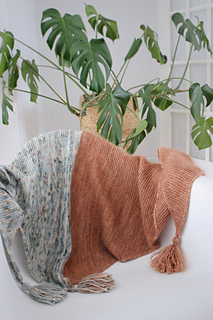patterns >  Lindsey Fowler's Ravelry Store
Lindsey Fowler's Ravelry Store
> Bennet Sister Shawl


















Bennet Sister Shawl
“Do not make yourself uneasy, my love. Wherever you and Jane are known you must be respected and valued; and you will not appear to less advantage for having a couple of—or I may say, three—very silly sisters.”
This shawl was, of course, inspired by one of my favorite sets of literary sisters. I didn’t grow up with sisters, but I like to imagine if I had, they would be like the Bennets. We would squabble and tease, but when the going gets tough, we would ride or die with each other. When designing a shawl for the modern Bennet sister, I created something that was practical but included a little bit of luxury for Lydia and Kitty.
This shawl is perfect for wrapping around your shoulders on long morning walks through dewy meadows, or covering up when Lady Cathrine de Bourgh barges in late at night to call you out.
Shape / Construction:
This shawl is a long triangle shaped shawl written from end to end and uses simple stitches to create graphic shapes and dynamic lines. The finished shawl at gauge is approximately 70” long with a 27” depth, perfect for wrapping around your neck like a cowl or over your shoulders.
Materials:
- Size US 6 Needles
- 50g/400yds of lace weight mohair
- 200g/800yds of fingering weight yarn
- Scrap yarn that coordinates for tassels (optional)
- Darning Needle
- Stitch marker
- Scissors
Yarn Recommendation:
Sample knit with 2 skeins of Berry Merino Fingering in “Bouquet” and 1 skein of Berry Mohair in “Orange Blossom”, both by Woolberry Fiber Co.
I recommend pulling for this pattern in one of two ways…
If you have a single skein of really special mohair in your stash, I would pair it with two skeins of a very simple semi solid in a similar base color and shade to your mohair. Or pair it with two skeins of undyed natural yarn for a really dramatic look. When you add the mohair on the second half, it will add a whisper of color and speckles to the piece and show off how the mohair changes the look of the yarn. This is how the pictured sample is worked.
The other recommended option is to find 800 yards of a special speckled color and add a simple plain mohair to the second half to change the texture but let the base yarn shine.
Bien entendu, ce châle a été inspiré par l’une de mes familles littéraires préférées : les Bennet. Je n’ai pas grandi avec des sœurs, mais j’aime à imaginer que si ça avait été le cas, nous serions comme les Bennet. On se chamaillerait et on se taquinerait, mais dans les moments difficiles, nous serions unies jusqu’à la mort. Lorsque j’ai conçu ce châle, pour une sœur Bennet des temps modernes, j’ai voulu créer quelque chose de pratique, mais aussi quelque peu luxueux, pour Lydia et Kitty. C’est le châle parfait à enrouler autour de ses épaules lors des longues promenades matinales dans les prairies couvertes de rosée, ou pour se couvrir lorsque Lady Catherine de Bourgh débarque tard dans la nuit pour vous interpeller.
Matériel :
Aiguilles 4 mm (US no 6)
50 g/365 m (400 vg) de fil mohair de grosseur 0, dentelle (« lace », en anglais)
200 g/730 m (800 vg) de fil de grosseur 1, très léger (« fingering », en anglais)
Restants de fils d’une couleur agencée pour les glands (facultatif)
Aiguille à laine
Marqueur de maille
Ciseaux
Fils recommandés :
L’échantillon a été tricoté avec deux écheveaux de Berry Merino Fingering, coloris Bouquet, et un écheveau de Berry Mohair, coloris Orange Blossom, tous deux de Woolberry Fiber Co.
Pour ce patron, je recommande ce qui suit :
Si vous avez un écheveau de mohair vraiment unique et spécial dans votre réserve, je le jumellerais avec deux écheveaux d’un coloris semi-uni très simple qui s’agence avec votre mohair. Vous pouvez aussi le jumeler à deux écheveaux de fil naturel non teint pour un look vraiment spectaculaire. Lorsque vous joignez le mohair dans la deuxième moitié, vous ajouterez un soupçon de couleur et de mouchetures au tricot, et vous verrez comment le mohair change l’aspect du fil. C’est de cette façon que j’ai tricoté l’échantillon illustré.
Sinon, je vous recommande de trouver 730 mètres (800 verges) d’un coloris moucheté unique et de joindre un mohair simple et uni sur la deuxième moitié pour modifier la texture sans voler la vedette au fil de base.
Échantillon :
En jersey, non bloqué
10 cm (4 po) = 26 mailles et 30 rangs
1021 projects
stashed
1452 times
- First published: December 2018
- Page created: December 7, 2018
- Last updated: March 24, 2021 …
- visits in the last 24 hours
- visitors right now





